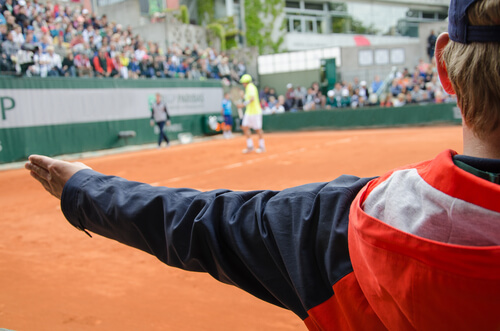One of the most definitive tests for human athleticism is sports. This does not mean that technology cannot facilitate it. Sport technology can be used for:
- tracking scores
- preventing injuries
- increasing engagement by fans
- analyzing the validity of plays and goals
There are many ways that technology and sports in the sports industry is changing the game. Genius Sports is using skeletal technology across Premier League to collect unprecedented data such as shot velocity and player speed. The technology tracks each Premier League player to collect this real-time data. Here are just a few more examples of how age-old sports are getting modern, high-tech revamps.
Wearable Technology
Wearable technology brands have been changing the way that sports are evaluated. Gone are the days when feeble human eyes had to make judgements in the movement. Today, thanks to the rise of everything from GPS trackers to RFID chips, sports officials can calculate scores with instant, impartial, and quantifiable data.
There are many types of wearable technology in football and other sports. Smart watches like Fitbit are popular with both professional athletes and amateur fitness buffs, and they’re suitable for a wide range of activities that can make use of calorie, step, distance, pulse and heart rate tracking.
Other, more specialized wearable technology examples include things like “smart clothing.” These items can be designed with specific activities in mind. For example, runners can invest in socks that are built with textile pressure sensors that will calculate whether they’re striking with their heels or the balls of their feet.
Advanced medical tech can take the form of everything from smart rings to sensor-filled shirts and leggings. There are even head-mounted displays (HMDs) that can be built into helmets to keep race car drivers in radio contact with their pit crews. Technology in sport science has grown quite sophisticated, and high-end fitness products can count steps, measure heart rates and even deliver electrocardiogram results to linked smartphones. Innovators are constantly pushing the boundaries of what their products can do.
Sensors
Sensors are often the driving force behind sports technology equipment and athletic gear. Sensors can be worn by athletes or built into their shoes and clothing. Depending on their unique functionality, sensors can be used for everything from tracking health and biometrics to delivering real time results to scoreboards.
There are many types of sensors used in sports, including:
- Heart rate monitors to track pulse and breathing patterns
- Inertial sensors that perform human motion analysis and can be used for recovery after injuries and accidents
- Accelerometers and gyroscopes to monitor position, rotation, acceleration and speed
- GPS (Global Positioning System) units to track velocity metrics outdoors
- LPS (Local Positioning System) units to measure velocity metrics indoors with higher accuracy than GPS
- VBT (Velocity Based Training) sensors to track performance in the weight room
- Sleep trackers to monitor and optimize sleep patterns
- Pressure sensors to determine the frequency and accuracy of how strikes or footfalls are landing
The benefits of wearable sports technology are numerous. Not only can they track health and fitness data to optimize athletic performance, but they can also be used to prevent injuries by identifying danger zones and predicting risky movements or patterns. When used by sports officials, they can also ensure accuracy during games, matches and performances.
Fan Engagement
The best fan experience in sports is a fully engaged one, and teams have started employing a variety of strategies to increase the energy and excitement of their most devoted.
Loyalty programs, for example, have become quite popular for sports fans. They offer all kinds of perks and privileges for those who regularly support their teams, including merchandise, meet and greets with athletes, and VIP access to stadiums. Some organizations are also experimenting with high-tech rewards in the form of blockchain and tokenization programs that can be used as currency. Others are selling team jerseys with chips in the sleeves that give season ticket holders loyalty rewards upon entry to a venue.
Digital fan engagement is also on the rise. Many of today’s stadiums are equipped with high-speed Internet, and this allows fans to access apps, replays, player stats, live commentary and more. They can also update their social media accounts in real time, which is a plus for teams and venues that are counting on engagement of fans on social media to drive up sales.
Fan engagement is usually digital outside of the stadium as well. A few online fan engagement examples include forums, fantasy leagues, and global fan clubs. There are also cutting-edge, new technologies in sports coming into play. There are things like virtual reality (VR), augmented reality (AR) and mixed reality (MR) are being used to transport fans away from their own computers and into digital sports arenas.
Fan engagement in sports is a complex and ever-evolving phenomenon. Only a decade ago, we’d list engagements of fans in football examples as “waving a giant foam finger” or “buying a beer at the stadium.” Today, however, it’s more likely to involve apps, fantasy leagues, and digital currency. Thanks to the rise in technology and the tech-savviness of modern audiences, you can expect this area of fan engagement to continue growing.
Disability and Accessibility
New sport technologies are making it possible for fans of all types to enjoy it, including disabled fans who might have struggled with inaccessible aspects of games and stadiums in the past.
For example, the Australian Open tennis tournament recently introduced descriptive audio for the visually impaired. They combined live ball position data with spatial sound effects to give fans a wholly immersive experience.
Disabled fans can also benefit from things like e-ticketing systems and other contactless or electronically-driven services. This lets them bypass the difficulties of a venue that might not have wheelchair access or disabled parking spaces near fan spaces such as ticketing stations and concession stands. Some venues have even launched “in-seat delivery services” that allow fans to order food and drink and have it delivered to them while they watch the game, and while this isn’t meant exclusively for disabled fans, it’s something that they can benefit from as game attendees.
Something else worth mentioning is the impact of new technology for disabled athletes themselves. Many para-sports have begun to incorporate technology in everything from motorized prosthetics to carbon fiber wheelchairs. There have also been exciting breakthroughs in the types of assistive technology that are allowed during certain sports. In swimming, for example, the visually impaired used to rely on “tappers” to physically touch them with a pole to signal that it was time to turn. Today, the same swimmers can use a digital device that utilizes infrared beams and ultrasonic technology to deliver a signal to their goggles.
Instant Replay
Instant replay is an example of the remarkable technology used in sports today. With this technology, officials are able to slow down and reexamine what happened during a play, which provides a much-needed second perspective for controversial sports moments.
Instant replay is used in games like baseball, football, cricket, rugby and soccer. It’s even used in combat sports and mixed martial arts. Instant replay is also common to see in video games based on sports where high-def videos and commentary can create immersive, lifelike experiences for players.
Instant replay isn’t without its controversies. For example, FIFA banned instant replays on screens in sports arenas during the 2010 World Cup for fear that it might incite fans to behave untowardly.
Ultimately, however, instant replays can be considered a critical tool for engagement of fans. They inspire discussion and debate while also serving as mementos of the game during recaps, commentaries and roundtable discussions. They’ve become a common and ever-present feature of technology in the sports world.
Related Resource: Do I Need a Degree in Sports Journalism to Become a Sports Journalist?
Sensor Tools
When administering and officiating sports, technology can succeed where humans may not. This guarantees fair judgment of the performance. It ensures that athletes win fairly.
Sensor tools, such as goal line technology, are often used to analyze whether a goal is valid. Goal line technology is used in cases where the naked eye cannot truly tell if a ball went past the goal line or if a player committed a foul or other offense.
Different sports use varying sensor tools. For example, cricket’s Hawk-Eye technology analyzes sound to determine if the ball smashed into the bat before it was caught. Hawk-Eye is also used to determine where the ball would have landed if it had not hit a player’s foot. Hawk-Eye establishes whether the ball was unfairly blocked from striking the wicket.
On the other hand, tennis sensor tools use laser beams to determine whether the tennis ball went out of bounds or not. Sensor technologies help to accurately determine the position of the ball at a given time, so they can be used to make in-game judgements without the fallibility of humans.
Sensors are also gaining traction in sports competitions such as gymnastics. The 2019 World Artistic Gymnastics Championships unveiled the first-ever artificial intelligence system designed to judge form, speed and technical accuracy in gymnasts. It was so advanced that it used 3D lasers to determine the angles of the athletes’ skeletal positions as they twisted and tumbled.
Timing Systems
Nobody uses a stopwatch when timing a race anymore. This means that differences in reaction time no longer affect the precision and consistency of a racing event.
Some sports wearable technology companies have created products to help with the accuracy of in-game timing and record keeping. The athletes will wear special clothing or accessories to track their motion and speed. Other times, timing tools are built into the venues themselves, or they’re utilized in systems within venues.
In many races, for example, the starter pistol is linked to a clock. Once the pistol goes off, the clock immediately starts timing the race. Other sports, including swimming, use a touch pad placed at the finish lanes as well as wearable inertial sensors to determine performance. Some racing events also use laser beams and photographs to determine winners.
The results of timing systems are often provided to the nearest thousand of a second. However, world and Olympic records are only recorded to the nearest hundredth of a second. This technique was established to eliminate insignificant errors.
RFID Chips
One of the best examples of technology in sports, RFID chips are used to time individual contestants in an event. They’re tiny devices with built-in antennas that relay wireless signals to tracking stations.
RFID chips are often used in long distance races to help broadcasters and viewers track the exact locations of contestants during a race. In this way, they’re a tool for fan engagement platforms as well as an instrument for judges to evaluate performance and success.
There are two types of RFID chips used in races: active and passive chips. Active chips have an in-built battery or power source and can determine the exact time a participant crosses a specific line. Passive chips can only be used with sensors placed in a mat because they do not have an in-built power source.
While they’re more of a specialized device than some of the other gadgets and gizmos on this list, RFID chips are a prime example of new technology in sport.
Equipment Development
Equipment development is another example of new technology in sports. In sports, safety is a key factor for the longevity of athletes as well as the enjoyment of fans. Equipment manufacturers have developed a number of devices to prevent injuries, reduce accidents and ensure the well-being of spectators.
In the 2010 season, for example, special helmets were used in the NFL after growing concerns over concussion injuries. The helmets were designed to absorb the shock caused by collisions and to protect athletes from suffering head and neck injuries. They joined other wearable technology in the NFL such as biometric monitors.
Similar technology is being used for sportss like auto racing and hockey to enhance the safety of these high-contact, high-impact activities.
Spectator safety is another issue during sporting events where fast-moving bodies or debris could cause harm to those in the vicinity. Many racing events, including NASCAR events, have replaced concrete barriers with Steel and Foam Energy Reduction (SAFER) barriers. Hockey venues have also started to experiment with different types of glass that are designed to absorb impact rather than shatter.
Conclusion
There have been many advancements in technology. New sports technologies have taken over today’s modern world. Many professional and amateur sports bodies have embraced new technologies in sports to protect athletes, engage fans, track world records and make it easier to officiate the games. From the wearable sports technology market to heightened fan experiences at sporting events, the future of athletics is increasingly digital.
Related Resources:



